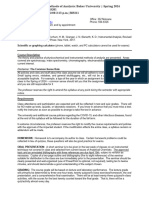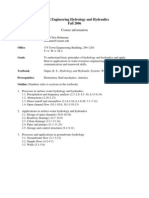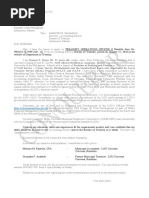Criteria 1 2 3 4 5 SCR WT TSCR (%) Attendance & Dicipline Aim / Purpose
Criteria 1 2 3 4 5 SCR WT TSCR (%) Attendance & Dicipline Aim / Purpose
Uploaded by
DINAMARIANASAMUJICopyright:
Available Formats
Criteria 1 2 3 4 5 SCR WT TSCR (%) Attendance & Dicipline Aim / Purpose
Criteria 1 2 3 4 5 SCR WT TSCR (%) Attendance & Dicipline Aim / Purpose
Uploaded by
DINAMARIANASAMUJIOriginal Title
Copyright
Available Formats
Share this document
Did you find this document useful?
Is this content inappropriate?
Copyright:
Available Formats
Criteria 1 2 3 4 5 SCR WT TSCR (%) Attendance & Dicipline Aim / Purpose
Criteria 1 2 3 4 5 SCR WT TSCR (%) Attendance & Dicipline Aim / Purpose
Uploaded by
DINAMARIANASAMUJICopyright:
Available Formats
Lab Report Rubric (Assessment Form)
Faculty of Civil and Environmental Engineering
Universiti Tun Hussein Onn Malaysia
Criteria
Laboratory: Hydraulics Laboratory
Section :
Subject Code: BFC 21201
Group Members:
1.
2.
3.
4.
5.
Experiment Title : Basic Hydrology
SCR
WT
TSCR (%)
Showed interest, used time very
well, guide other students and very
focused on experiment
Student can explain the results of
the experiment in detail and the ways
in which they relate to the research
focus. The student can also evaluate
the significance of the experiment to
the real situation
Attendance &
Dicipline
Student in laboratory more
than 1 hour late
Student in laboratory within
30 minutes to 1 hour late
Student in laboratory within 10
to 30 minutes late
Student in laboratory just
before laboratory start
Student in laboratory 10 minutes
earlier
Aim / Purpose
Purpose is not identified
Relevant variables are not
described
Purpose is somewhat vague
Relevant variables are not
described
Purpose is identified
Relevant variables are
described
Purpose is clearly identified
Relevant variables are described
Materials
(optional)
There is not a list of the
necessary lab materials
Most lab materials included
All necessary lab materials
included and listed
All necessary lab materials included
and listed in an organized manner
Procedure
(optional)
Procedures are not listed
Procedures are listed but not
in clear steps
Purpose is identified
Relevant variables are
described in somewhat unclear
manner
All necessary lab materials
included but not listed in any
particular order
Procedures are listed in clear
steps but not numbered and/or
in complete sentences
Procedures are listed in clear
steps
Each step is numbered and in
a complete sentence
Data lacks precision
Greater than 20% difference
with accepted values
Good representation of the
data using tables and/or graphs
Less than 15% difference with
accepted values
Precision is acceptable
Accurate representation of the
data using tables and/or graphs
Data is fairly precise
Less than 10% difference with
accepted values
Trends / patterns are not
analyzed
Answers to questions are
incomplete
Analysis is inconsistent
A statement of the results is
incomplete with little reflection
on the lab
Trends / patterns are logically
analyzed for the most part
Questions are answered in
complete sentences
Analysis is general
A statement of the results of
the lab indicates whether
results support the hypothesis
Did the job but did not appear
to be very interested. Focus lost
on several occasion
Trends / patterns are logically
analyzed
Questions are answered in
complete sentences
Analysis is thoughtful
Accurate statement of the
results of the lab indicates
whether results support the
hypothesis
Possible sources of error
identified
Used time pretty well. Stayed
focused on the experiment most
of the time
Procedures are listed in clear steps
Each step is numbered and in a
complete sentence
Diagrams are included to describe
the set-up
Accurate representation of the data
using tables and/or graphs
Graphs and tables are labeled and
titled
Data is precise with less than 5%
difference with accepted values
Trends / patterns are logically
analyzed
Questions are answered thoroughly
and in complete sentences
Analysis is insightful
Accurate statement of the results of
lab indicates whether results support
hypothesis
Possible sources of error and what
was learned from the lab discussed
Data
Analysis /
Result
Discussion
Data is not represented or is
not accurate
Trends / patterns are not
analyzed
Questions are not answered
Analysis is not relevant
No disussion was included or
shows little effort and reflection
on the lab
Participation
(during
experiment)
Student was hostile about
participating
Participation was minimal
Interview (for
short reports)
Student cannot answer
questions about the experiment
Student can answer some
questions about the experiment
NAME OF LECTURER :
Student can answer questions
about the experiment and
begins to make connections
between the experiment and its
applications
Student can explain the
results of the experiment in
detail and the ways in which
they relate to the research focus
SIGNATURE :
DATE :
Note : SCR = SCORE, WT = WEIGHTAGE, TSCR = TOTAL SCORE
TOTAL SCORE :
FACULTY OF CIVIL & ENVIRONMENTAL ENGINEERING
WATER ENGINEERING LABORATORY
LABORATORY PAPER INSTRUCTION
Subject Code
BFC 21201
Experiment
Code
MKA 01 (a)
Experiment Title
BASIC HYDROLOGY
Section
STUDENTS ETHICAL CODE (SEC)
DEPARTMENT OF WATER & ENVIRONMENTAL ENGINEERING
FACULTY OF CIVIL & ENVIRONMENTAL ENGINEERING
UNIVERSITI TUN HUSSEIN ONN MALAYSIA
BATU PAHAT, JOHOR
I declare that I have prepared this report with my own efforts. I also
declare not receive or give any assistance in preparing this report and
make this affirmation in the belief that nothing is in, it is true
.
(STUDENT SIGNATURE)
NAME
MATRIC NO :.
DATE
:....
*This SEC sheet/student is compulsory compiles in this report
FACULTY OF CIVIL & ENVIRONMENTAL
PAGE NO
ENGINEERING
1/3
1
1
DEPARTMENT OF WATER & ENVIRONMENTAL
ENGINEERING
EDITION
REVIEW NO
:
:
WATER ENGINEERING LABORATORY
EFFECTIVE DATE
: 17/05/2005
TITLE : BASIC HYDROLOGY
AMENDMENT DATE :
17/05/2005
PART A: BASIC HYDROLOGY
1.0 OBJECTIVE
To identify the relationship between rainfall and runoff.
2.0
LEARNING OUTCOMES
At the end of the course, students should be able to apply the knowledge and skills they have
learned to:
a. Understand the basic terms in hydrology.
b. Understand the concept of watershed area including time of concentration
(tc) and outlet or concentration point.
c. Understand the factors which influence the runoff.
3.0 THEORY
1. Runoff is generated by rainstorms and its occurrence and quantity are dependent on the
characteristics of the rainfall event, i.e. intensity, duration and distribution. The rainfall-runoff
process is extremely complex, making it difficult to model accurately. There are, in addition,
other important factors which influence the runoff generating process like natural surface
detention, soil infiltration characteristics and the drainage pattern formed by natural flow paths.
The soil type, vegetative cover and topography play as important roles. Rainfall and runoff are
very important hydrologic components because of their direct relations with water resources
quantity, flood, streamflow and design of dam and hydraulic structure.
4.0 EQUIPMENTS
Basic hydrological instrument, stop watch and rain gauge.
FACULTY OF CIVIL & ENVIRONMENTAL
ENGINEERING
PAGE NO
1/3
DEPARTMENT OF WATER & ENVIRONMENTAL
ENGINEERING
EDITION
REVIEW NO
:
:
1
1
WATER ENGINEERING LABORATORY
EFFECTIVE DATE
: 17/05/2005
TITLE : BASIC HYDROLOGY
AMENDMENT DATE :
17/05/2005
5.0 PROCEDURES
Case 1: Flat and sandy soils surface profile (without slope)
Case 2: Flat and sandy soils surface with 1:100 slope profile
1. Adjust the rail at side of the catchment area to justify according the requirement for case 1 (from
upstream to downstream).
2. And then move the profile board to obtain the cross section at the upstream as in case of flat and
sandy soils surface from upstream to downstream.
3. Use the steel ruler to measure the depth (mm) of the sandy soils.
4. Switch on the pump and start the stop watch at the same time.
5. Record the discharge every 30 seconds (during the rainfall). Also record the reading from the rain
gauge (mm).
6. When the peak discharge achieved (after 6 discharge readings with same values obtained),
switch off the pump to stop the rainfall. Record the time while stop of rainfall.
7. At the same time, the discharge readings must be recorded for each 30 seconds until
the values reach nearly zero.
8. Repeat the above procedures for case 2 and case 3.
FACULTY OF CIVIL & ENVIRONMENTAL
ENGINEERING
PAGE NO
2/3
1/3
DEPARTMENT OF WATER & ENVIRONMENTAL
ENGINEERING
EDITION
REVIEW NO
:
:
1
1
WATER ENGINEERING LABORATORY
EFFECTIVE DATE
: 17/05/2005
TITLE : BASIC HYDROLOGY
AMENDMENT DATE :
17/05/2005
6.0 RESULT AND CALCULATIONS
TABLE 6.1 Basic hydrological experiment results
Time,
t
(s)
30
60
90
120
150
180
210
240
270
300
330
360
390
420
450
480
510
540
570
600
630
660
690
720
750
780
810
840
870
900
930
960
990
1020
Case 1
Water Level
(cm)
(mm)
Case 2
Discharge
(liter/min)
(m/s)
Rain
gauge
reading
(mm)
Water Level
(cm)
(mm)
Discharge
(liter/min)
(m/s)
Rain
gauge
reading
(mm)
FACULTY OF CIVIL & ENVIRONMENTAL
ENGINEERING
PAGE NO
3/3
1/3
DEPARTMENT OF WATER & ENVIRONMENTAL
ENGINEERING
EDITION
REVIEW NO
:
:
1
1
WATER ENGINEERING LABORATORY
EFFECTIVE DATE
: 17/05/2005
TITLE : BASIC HYDROLOGY
AMENDMENT DATE :
17/05/2005
7.0 QUESTIONS
1. Plot the discharge (unit m3/s) versus time (second) graph separately from the above values
for each cases (case 1 to case 3).
2. From the graph plotted, determine: (a) Time concentration (b) Rainfall duration, (c) Peak
discharge, (d) Runoff volume, (e) Rainfall intensity and (f) Storage volume.
3. Provide a table for all the results obtained from (2) and make comparisons with case 2 and
case 3.
Prepared by:
WAN AFNIZAN WAN MOHAMED
Signature:
Date: 14 July 2008
Updated by:
SABARIAH MUSA
Signature:
Date : 14 February 2014
You might also like
- Edce 661 High School Transition ProgramDocument13 pagesEdce 661 High School Transition Programapi-35620523550% (4)
- LosDocument17 pagesLosMohamadRosli100% (4)
- Lab Sheet - Infiltration TestDocument8 pagesLab Sheet - Infiltration TestDINAMARIANASAMUJI0% (1)
- Mka 03 (A) Pelton TurbineDocument6 pagesMka 03 (A) Pelton TurbineNoor Azlan Ismail0% (1)
- Laboratory Worksheet: Center For Diploma StudiesDocument6 pagesLaboratory Worksheet: Center For Diploma StudiesSyihabuddin Yusoff0% (1)
- Proctor Standard Soil CompactionDocument11 pagesProctor Standard Soil CompactionAmin Saufi100% (3)
- Sieve Analysis of Coarse Aggregate TerkiniDocument8 pagesSieve Analysis of Coarse Aggregate TerkiniShazrin Zakaria0% (3)
- RPP - Hydrology UthmDocument5 pagesRPP - Hydrology UthmHe YapNo ratings yet
- MECH243 Syllabus - Fall 2016Document2 pagesMECH243 Syllabus - Fall 2016Joseph KfouryNo ratings yet
- Cover Page Lab ReportDocument2 pagesCover Page Lab ReportLuqman IzzuddinNo ratings yet
- ChE 323L OBE Course Syllabus 2014-2015 11-20-14Document11 pagesChE 323L OBE Course Syllabus 2014-2015 11-20-14Jan Laurence OmegaNo ratings yet
- Cover Page Lab Report Clb11003 Jan2015Document4 pagesCover Page Lab Report Clb11003 Jan2015qilahmazlanNo ratings yet
- CE 329 - DU, FeiDocument4 pagesCE 329 - DU, FeiHAFIZ ARSALAN ALINo ratings yet
- Moment Influence Line LabsheetDocument12 pagesMoment Influence Line LabsheetZAXNo ratings yet
- BT1010 IrrigationTechniquesDocument2 pagesBT1010 IrrigationTechniquesSooraj Kannan, P.V.No ratings yet
- Exp 3Document7 pagesExp 3amin shukriNo ratings yet
- EME 109 SyllabusDocument10 pagesEME 109 SyllabusSteelcoverNo ratings yet
- CH341 SP 24Document5 pagesCH341 SP 24j perryNo ratings yet
- Course Manual 13-14Document120 pagesCourse Manual 13-14Brady XuNo ratings yet
- Plate and Frame Filter Press: Cpb21404 Separation ProcessDocument15 pagesPlate and Frame Filter Press: Cpb21404 Separation ProcessRashdan CskNo ratings yet
- FULL Plate and Frame Filter Press PDFDocument16 pagesFULL Plate and Frame Filter Press PDFMuhammad Asyraf IINo ratings yet
- ENVE206 SyllabusDocument2 pagesENVE206 Syllabusyasemin yılmazNo ratings yet
- Heat Transfer Lab Manual-2014Document27 pagesHeat Transfer Lab Manual-2014thobyyNo ratings yet
- HydraulicsDocument7 pagesHydraulicsBernard PalmerNo ratings yet
- CE 460 Syllabus_Summer 2023Document3 pagesCE 460 Syllabus_Summer 2023singjim58No ratings yet
- Bacteria Count LabsheetDocument4 pagesBacteria Count LabsheetWai SinNo ratings yet
- ETZ C362 HandoutDocument4 pagesETZ C362 HandoutchetanursNo ratings yet
- CIVE 306 - Syllabus v5Document3 pagesCIVE 306 - Syllabus v5jean paulNo ratings yet
- Outline For Lab ReportDocument5 pagesOutline For Lab ReportasriNo ratings yet
- Aykan07.05.2015 20.27.26ders PDFDocument8 pagesAykan07.05.2015 20.27.26ders PDFRobiel GashuNo ratings yet
- SYL CHEM 2011 Summer 2016 Al-MasumDocument7 pagesSYL CHEM 2011 Summer 2016 Al-MasumImani ChambersNo ratings yet
- Manual CGE558 Geology & Drilling LabDocument18 pagesManual CGE558 Geology & Drilling LabShalihan MustafaNo ratings yet
- MEMB221 Lab ManualDocument66 pagesMEMB221 Lab ManualRynda BlyndaNo ratings yet
- Chem101 Courseoutline Spring 2012-13Document3 pagesChem101 Courseoutline Spring 2012-13emuphychemNo ratings yet
- Petroleum Engineering 663: Formation Evaluation and The Analysis of Reservoir PerformanceDocument5 pagesPetroleum Engineering 663: Formation Evaluation and The Analysis of Reservoir PerformancemanningamanningaNo ratings yet
- Lab Manual Mechanic of Materials SEM 2 20132014Document65 pagesLab Manual Mechanic of Materials SEM 2 20132014saruwatari michiyo100% (1)
- Momemtum Transfer July Dec 2016 Batch Course Plan R2 - 2Document7 pagesMomemtum Transfer July Dec 2016 Batch Course Plan R2 - 2Swapnil TripathiNo ratings yet
- OPEN ENDED LAB 4 Bernoulli TheoremDocument4 pagesOPEN ENDED LAB 4 Bernoulli Theoremeris cameliaNo ratings yet
- Delivery Plan For Fluid MechanicsDocument8 pagesDelivery Plan For Fluid MechanicsJayakaran PachiyappanNo ratings yet
- Lab Menual PDFDocument45 pagesLab Menual PDFnabilahNo ratings yet
- Gary Thesis Draft2Document33 pagesGary Thesis Draft2KP MIkeNo ratings yet
- Hydraulics & Fluid Mechanics Handout 2012-2013Document4 pagesHydraulics & Fluid Mechanics Handout 2012-2013Tushar Gupta0% (1)
- Chem 105 Syllabus 2013 SpringDocument4 pagesChem 105 Syllabus 2013 SpringemuphychemNo ratings yet
- CGN3501C - Lab - CECE - Fall2020 PDFDocument7 pagesCGN3501C - Lab - CECE - Fall2020 PDFStefhany RapioNo ratings yet
- Machine Design and CAD Lab ManualDocument45 pagesMachine Design and CAD Lab ManualPraviin Jayakumar100% (3)
- Birla Institute of Technology & Science, Pilani Work Integrated Learning ProgrammesDocument6 pagesBirla Institute of Technology & Science, Pilani Work Integrated Learning ProgrammesmubashkNo ratings yet
- CHE 318-Ccourse Outline-2015Document3 pagesCHE 318-Ccourse Outline-2015Waleed WaleedNo ratings yet
- SyllabusDocument4 pagesSyllabusIan HoldemanNo ratings yet
- CE 341A Soil Mechanics LaboratoryDocument7 pagesCE 341A Soil Mechanics Laboratoryomotoriogun samuelNo ratings yet
- Chem 3830 Lab Manual - 2008Document127 pagesChem 3830 Lab Manual - 2008hamid_hinnaNo ratings yet
- Final Lab Report - BernoullisDocument14 pagesFinal Lab Report - BernoullisDaphneNo ratings yet
- Full Exp Cooling TowerDocument16 pagesFull Exp Cooling TowerFareez AizatNo ratings yet
- CCB 2073 - Analytical Chemistry Laboratory Manual Preface - Jan Sem 2014 - 060214Document12 pagesCCB 2073 - Analytical Chemistry Laboratory Manual Preface - Jan Sem 2014 - 060214dinesh93No ratings yet
- CPP Lab Report 4Document11 pagesCPP Lab Report 4Muhammad Danial KhairuddinNo ratings yet
- كتاب معمل ميكانيكا الموائعDocument91 pagesكتاب معمل ميكانيكا الموائعaeaeae335No ratings yet
- Abstract Writing ProcessDocument18 pagesAbstract Writing ProcessAli HassanNo ratings yet
- Chem1001 2014 Sem-2Document4 pagesChem1001 2014 Sem-2DoonkieNo ratings yet
- Fluids Mechanics Lab ManualDocument30 pagesFluids Mechanics Lab ManualHaseen KaurNo ratings yet
- Systematic Methods of Water Quality Parameters Analysis: Analytical MethodsFrom EverandSystematic Methods of Water Quality Parameters Analysis: Analytical MethodsRating: 1 out of 5 stars1/5 (1)
- An Introductory Course of Quantitative Chemical Analysis With Explanatory NotesFrom EverandAn Introductory Course of Quantitative Chemical Analysis With Explanatory NotesRating: 1 out of 5 stars1/5 (1)
- Scientific Integrity and Ethics in the GeosciencesFrom EverandScientific Integrity and Ethics in the GeosciencesLinda C. GundersenNo ratings yet
- Ra 10915 (Phil Agicultural & Biosystems Eng'g Act of 2016Document34 pagesRa 10915 (Phil Agicultural & Biosystems Eng'g Act of 2016almorsNo ratings yet
- Using and Evaluating Instructional MaterialsDocument1 pageUsing and Evaluating Instructional MaterialsJonathan Delos SantosNo ratings yet
- Teacher Perception On Principals Leadership Style and School Climate in KelantanDocument7 pagesTeacher Perception On Principals Leadership Style and School Climate in KelantankimiNo ratings yet
- Treasury Service (SEAL) Program BCLTE and ICLTE. I Have Been A Data Analyst at Accenture Inc.Document2 pagesTreasury Service (SEAL) Program BCLTE and ICLTE. I Have Been A Data Analyst at Accenture Inc.Ramon F. Reyes IIINo ratings yet
- Iso 9001 (2000) Qms Management ResponsibilityDocument16 pagesIso 9001 (2000) Qms Management ResponsibilityRana Muhammad Arif KhanNo ratings yet
- Back To School News Fith Grade 1819Document5 pagesBack To School News Fith Grade 1819api-297842592No ratings yet
- Communication ResearchDocument284 pagesCommunication ResearchGeorge Baffour AwuahNo ratings yet
- Coursework EDUP2132 TESL - 2021Document3 pagesCoursework EDUP2132 TESL - 2021Puteri AdlinaNo ratings yet
- Salman KhokharDocument3 pagesSalman KhokharSalman KhokharNo ratings yet
- Article Review By:eva Noviana BudiyantiDocument4 pagesArticle Review By:eva Noviana BudiyantiEva Noviana BudiyantiNo ratings yet
- Sample Lessons For Adolescent ProgramDocument5 pagesSample Lessons For Adolescent ProgramYunita LubisNo ratings yet
- Portfolio Self-Assessment Rubric Matrix-2Document1 pagePortfolio Self-Assessment Rubric Matrix-2api-340611503No ratings yet
- Lte - 8Document8 pagesLte - 8Judy Ann PalingcodNo ratings yet
- PBT mt11060 nx2 GDocument368 pagesPBT mt11060 nx2 Glakshmichandranath889No ratings yet
- Appropriate Blanks And/or by Supplying The Answers On The BlanksDocument3 pagesAppropriate Blanks And/or by Supplying The Answers On The BlanksYanah MarieNo ratings yet
- Pre-K HandbookDocument14 pagesPre-K Handbookapi-259647181No ratings yet
- Critical Thinking-What Can It Be?: Matthew LipmanDocument7 pagesCritical Thinking-What Can It Be?: Matthew LipmanmarcosmcjNo ratings yet
- Barkadas: Department of Education Schools Division of Tarlac Province Pao Elementary SchoolDocument1 pageBarkadas: Department of Education Schools Division of Tarlac Province Pao Elementary SchoolRenabeth CastroNo ratings yet
- Students' Attitudes Towards The Study of English and French in A Private University Setting in GhanaDocument12 pagesStudents' Attitudes Towards The Study of English and French in A Private University Setting in Ghanaksimpeh2001No ratings yet
- College Sports PresentationDocument21 pagesCollege Sports PresentationSagar ShindeNo ratings yet
- Essay Student Exchange ConvertDocument3 pagesEssay Student Exchange ConvertIlma SyifannisaNo ratings yet
- Bryan Cahulogan DLP For English 3Document4 pagesBryan Cahulogan DLP For English 3Bryan Riños Cahulogan IINo ratings yet
- 7TH Domain of PPSTDocument38 pages7TH Domain of PPSTJackylyn Libay100% (1)
- Chapter 9 Classroom ManagementDocument32 pagesChapter 9 Classroom Managementapi-2198578980% (1)
- VTU IMrDocument6 pagesVTU IMrprasadkh90No ratings yet
- Social Clock EssayDocument2 pagesSocial Clock Essayapi-355220300100% (1)
- Self Esteem in ChildrenDocument4 pagesSelf Esteem in ChildrenAlexandra AntipaNo ratings yet
- UGC NET PreparationDocument7 pagesUGC NET PreparationThenmozhi MargabanduNo ratings yet
























































































